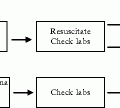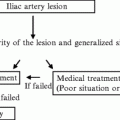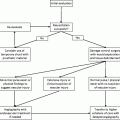Patients
Modifier
Recommendation
Grade
1st episode DVT
Calf
Proximal
Transient (reversible) risk factor
3 months VKA
1A
1st episode DVT
Idiopathic
At least 6–12 months
and
consider indefinite
1A
2A
VTE patients
Rx’ed with VKAs
INR 2.0–3.0
Against high intensity
1A
1A
1st episode DVT
Cancer
LMWH × 3–6 months
and
anticoagulation indefinitely (or until cancer resolved)
1A
1C
1st episode DVT
Antiphospholipid Ab
and
≥2 other thrombophilic conditions
Indefinite anticoagulation
2A
Recurrent DVT
Indefinite anticoagulation
2A
VTE patients
Indefinite anticoagulation
Reassess risk/benefit at routine intervals
1C
2.
Compression therapy and ambulation
At the time of diagnosis and initiation of anticoagulation, the involved leg(s) should be wrapped snugly from the toes to the thigh and the patient encouraged to ambulate. This significantly reduces early morbidity, improves thrombus resolution, and reduces postthrombotic morbidity. Elastic compression stockings with a gradient of 30–40 mmHg should be prescribed long term, to be worn from the time the patient awakens in the morning until going to bed at night. This reduces the risk of postthrombotic morbidity by 50%.
3.
Inferior vena cava filters
(a)
Absolute indications
Contraindication to anticoagulation
Documented failure of anticoagulation
Complications of anticoagulation
(b)
Relative indications
Large free floating thrombus in vena cava (especially prior to intervention)
Massive PE
Patients undergoing pulmonary embolectomy
Recurrent PE in the presence of filter
Patients undergoing thrombolysis for iliofemoral DVT
DVT with limited cardiopulmonary reserve
(c)
Prophylactic indications
Absence of DVT or PE in a patient with high risk of PE (i.e., pelvic fracture)
4.
Strategy of thrombus removal
Removal of thrombus from the deep venous system is an appropriate goal of treatment, especially in patients with extensive DVT. Successful thrombus removal eliminates venous obstruction and increases the likelihood of maintaining valvular function.
(a)
Thrombolytic therapy
Systemic thrombolysis is generally inadequate because very little of the infused plasminogen activator penetrates the clot to activate fibrin-bound plasminogen. The delivery of a thrombolytic agent directly into the venous clot allows efficient activation of fibrin-bound plasminogen with small doses of plasminogen activator. Clinical success rates have been encouragingly high using pharmacomechanical techniques during catheter-based intervention.
Patients with acute axillosubclavian vein thrombosis are well served with catheter-directed or pharmacomechanical thrombolysis. Following lysis, an underlying stenosis is often found, usually in the subclavian vein as it passes between the first rib and clavicle. This is best treated by excision of the first rib followed by balloon venoplasty and stenting, if necessary. Stenting of the subclavian vein as it crosses the first rib should be avoided prior to first rib resection, as the stent will be crushed, resulting in reocclusion and a potentially worse outcome.
(b)
Venous thrombectomy
Contemporary venous thrombectomy is an effective technique designed to remove clot from the entire lower extremity venous system. An associated small arteriovenous fistula (AVF) and a small distal catheter through which heparin is infused to achieve systemic anticoagulation are techniques which help to reduce rethrombosis.
A large multicenter randomized trial in patients with iliofemoral DVT comparing venous thrombectomy, AVF, and anticoagulation versus anticoagulation alone showed significantly better patency, lower venous pressure, less edema, and fewer postthrombotic symptoms at 6 months, 5 years, and 10 years.
7 Open Operative Procedures
1.
Venous thrombectomy for acute DVT








